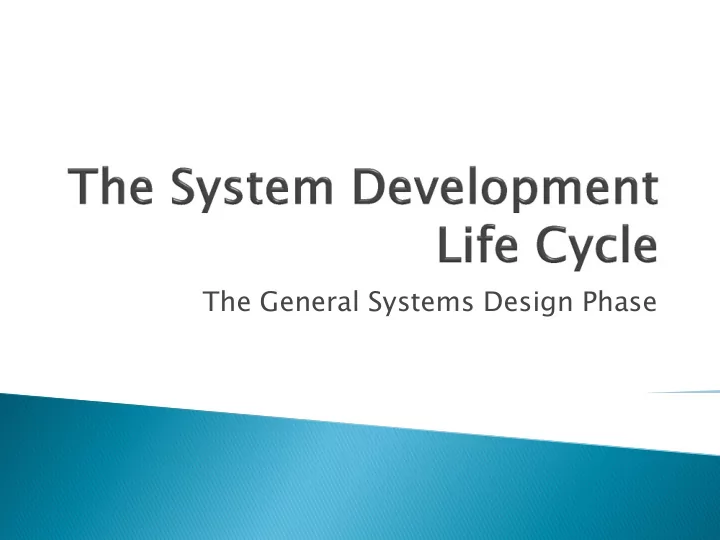

The General Systems Design Phase
Define three systems design categories Discuss the use of rapid application development (RAD) in general systems design and describe RAD's four key elements. Describe the structure-oriented design approach Descript the object-oriented design approach Compare the structure-oriende design approach with the object oriented design approach.
System Planning Systems Maintenance Analysis SDLC System Conceptual Systems Implement Design ation System Detailed Evaluation System And Design Selection
Global-based systems Group-based systems Local-based systems
Global-based systems Covers the entire organization Large, complex, high volume of transactions Critical to a company’s success
Group-based systems Developed for departments, or units, or branches of an organization Examples, billing system for a hospital, employee management systems for a hospital, patient-records management systems for a hospital
Local-based systems Smaller scale system intended to support a small group or users Examples: an executive information system (EIS) for a few strategic-level executives
The Structured Approach The Object-Oriented Approach Will use common methods, tools, and techniques
1. Joint application development (JAD) 2. Specialists with advanced tools (SWAT) teams 3. Computer-aided systems and software engineering (CASE) tools 4. Prototyping
SDLC, Prototyping, CASE, RAD : uses an engineered disciplined top-down decomposition (The waterfall model) The process-oriented approach Used when the inputs, processes, and outputs are well defined or established The data-oriented design approach Used when the components are less defined and for defining decision-making tasks
Designing and building systems using reusable software objects; uses methods, tools, and techniques as the structured approach. Goal of object-oriented approach during the design phase, identify Object Classes 1. Relationships 2. Attributes 3. Inheritance 4.
Have a database or repository of object classes The classes are retrieved and extended to apply to new applications, also providing additional object-classes for the library. Adds reusability.
Step1 : Identify object classes Step 2: Identify Relationships Step 3: Identify Attributes Step 4: Identify Inheritance and build a class hierarchy
Modularity – common to both approaches Top-down versus Bottom-up Design Using existing Object Class Libraries Structured approach defines data in terms of files and databases, and software modules to access the data; Object- oriented approach “encapsulates” data and attributes as software objects.
Terms ms to k know, or be familiar with now Terms ms for Next t Year Bottom-up Global-based Object RAD Encapsulation design Systems Classes Group-based Object-class Specialists Inheritance systems library with Advanced Tool teams Data Local-based Object- Structured- Polymorphism Dictionary systems oriented oriented design design Data-oriented Messages Object- Top-down Subclass approach oriented design programming Executive Modularity Process- Superclass Information oriented System (EIS) approach
Recommend
More recommend